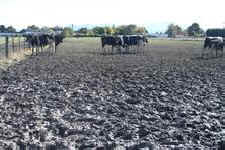
The Unequal Distribution of Waste
A Meat and Dairy Industries Article from All-Creatures.org
FROM
James McWilliams
August 2012
Rotational grazing...Just another way the food movement seeks to justify the suffering they cause with the supposed environmental benefits their way of eating claims to bring us. As always, it still seems the best solution is to leave animals out of the equation altogether.

Advocates of sustainable animal agriculture routinely tell us that
animals are required for environmentally responsible food production. It’s
not uncommon for these advocates to go so far as to argue that animal
agriculture will substantially mitigate global warming. Despite the inherent
wastefulness of raising animals for food, these supporters argue that
eco-correct farming demands animal waste to fertilize fields to grow the
grasses that improve soil respiration and sequester carbon.
They portray rotational grazing as a self-sustaining system that’s more in
tune with the rhythms of nature. The way they spin the narrative, it appears
to be an appealing solution to the environmental horror of industrial animal
agriculture (speaking of which, check out the video I posted today in “Of
Interest.”)
Rotational grazing, however, is anything but self-sustaining. In fact, it
requires intense management skills, skills that the vast majority of farmers
lack. Even the best rotational grazers, however, face what I see as an
insuperable problem. Indeed, As I research this increasingly popular system
of raising animals (for The Modern Savage), I’m coming to the new conclusion
(new, at least, for me) that organizing cattle on pasture is marked by an
inherent contradiction with unsustainable environment consequences. I reach
this conclusion after reading scores of rotational grazing manuals published
by university extension agencies.
The tension centers on animal waste distribution and grazing capacity.
Pastures that are sparsely packed with cattle are pastures that suffer poor
waste distribution. Cattle pee and poop around water supplies, under shade
trees, and outside the gates of their enclosures. They do not evenly
distribute their waste. Not even remotely. The field is thus not properly
fertilized. The main way to mitigate this problem is to pack cattle with
greater density, thus improving nutrient distribution.
This decision, however, quickly leads to what called “pugging”—the
transformation of soil around watering spots into muck that can be 18 inches
thick—and overgrazing in the center of the pastures. Pugging and overgrazing
counteract the benefits of nutrient distribution because the soil is less
able to absorb the waste. The rotational grazer is thereby trapped.
I suppose diehard rotational grazers will say it’s all about finding the
sweet spot between these two countervailing trends. But from what I’ve read,
that’s a very tough sweet spot to find, leaving me to conclude that,
pragmatically speaking, the environmental benefits of rotational grazing are
more theoretical and rhetorical that real. Just another way the food
movement seeks to justify the suffering they cause with the supposed
environmental benefits their way of eating claims to bring us. As always, it
still seems the best solution is to leave animals out of the equation
altogether.
Return to Environmental Articles
Return to The Meat and Diary Industries
Animal Slaughter Kill Counter:
Number of animals killed in the world by the fishing, meat, dairy and egg industries, since you opened this webpage.
0 marine animals
0 chickens
0 ducks
0 pigs
0 rabbits
0 turkeys
0 geese
0 sheep
0 goats
0 cows / calves
0 rodents
0 pigeons/other birds
0 buffaloes
0 dogs
0 cats
0 horses
0 donkeys and mules
0 camels / camelids







